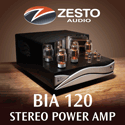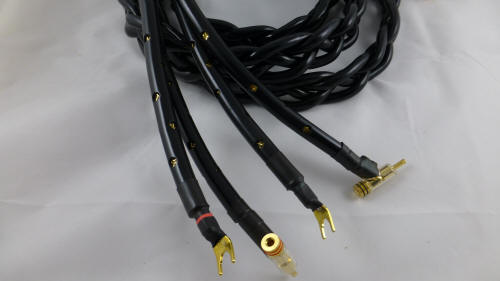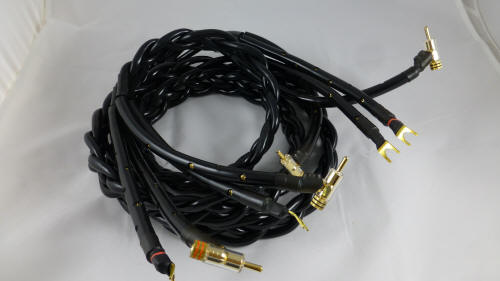|
|
You are reading the older HTML site
Positive Feedback ISSUE 71
danacable Diamond Speaker Cables as reviewed by Michael Wechsberg
John Zurek recently took a look at the DanaCable Sapphire Reference speaker cables in Issue 69 of PFO and was mightily impressed. In the same issue, Robert Levi listened to the DanaCable Diamond Reference interconnects and he was similarly blown away by their neutral and musical sound, especially for their very reasonable price. What I have to tell you about is something in between these two items, the Diamond Speaker Cables. In the DanaCable product line the Diamond series sits above the Sapphire Reference cables and just below the top-of-the-line Diamond Reference series. Dana Cables are made in the USA by their brilliant designer Dana Robbins (an honest to goodness electrical engineer with a good set of ears surrounding an insightful mind), and they are distributed by Gingko Audio. In the latest price list on the Gingko Audio web site the Diamond Speaker Cables cost $4350 for a 2-meter set compared to $2495 for the Sapphire Reference Speaker Cables. Dana Robbins believes in the basic principles of engineering and materials and that adhering to these basics results in the most neutral, full-spectrum cable design. He believes further, as I do, that no cable at all would be the best way to go, so, he reasons, minimizing the basic electrical parameters of resistance, capacitance and inductance of the cable is the next best thing. His video experiment comparing the DanaCable to no cable at all is entertaining and informative. All DanaCable speaker cables have a unique weave design where multiple lengths of cable are interwoven to reduce the inductance and capacitance. They also use a lot of Oxygen Free Copper to keep the resistance as low as possible as well. Whereas the Sapphire Reference speaker cables interweave 8 lengths of 8 awg copper cable, the Diamond cables employ 4 weaves of much thicker 4 awg cables. Each of the 4 weaves has a termination so the cable can easily be used for bi-wiring if desired. That is, the positive side of the cable has one weave with a spade lug and a second weave with a locking banana plug. The same configuration is used on the negative side. If single-wire operation is desired, as in my case, then the spade and banana connections can be locked together. The terminations are gold-plated and of very high quality. The cables came in a very nice leatherette box together with a certificate of measurement signed by Mr. Robbins. The measurements reveal the low values of R, L and C achieved by the design (e.g.., the resistance of both of my 2.5m cables was just 0.0034 ohms), as well as the match between the two cables, which was near perfect.
I inserted the DanaCable Diamond speaker cables in my system between the EAR 890 tubed amplifier and my Marten Django XL speakers, in place of the Kubala-Sosna Emotion cables. Most of the other cables in my system, including all but one power cord, are also from Kubala-Sosna. Dana advises the cables need at least 50 hours of break-in, preferable more, so I just kept them in the system for a couple of weeks of casual listening without seriously paying attention to them, but I did notice they made my system sound quite glorious. Before going into what I heard, I need to repeat some basic caveats about my views on cable reviews. I only have one reference system so I can only report on the way these cables sound in that one system (although as you will see I did make some adjustments to the system during the review). They could sound different in another system. I do have quite a bit of experience as a reviewer listening to many cables and a large amount of different gear so I can usually separate out some characteristics of the cable from characteristics of the equipment itself. I also am very tuned in to the sound of my reference system. But, in truth, I never feel as confident about the accuracy of my cable reviews as I am of reviews of most other types of gear. I think the same is true for most reviewers. The impact of a cable on the sound that comes out of an audio system depends on the way the cable interacts with the components on either end, and on the environment in the listening room. Choosing the right cable can enable a system to sound its best, but for the most part cables degrade the sound of audio components rather than improve them. All that being said the Dana Diamond cables are outstanding and can be used with confidence in systems at all price levels, including very high-end systems. Dana Robbins has achieved his goal of neutrality in these speaker cables, as that is the first word I thought of when first hearing them. They have a beautiful and luscious sound from top to bottom, and one that is very involving. One thing that stood out in initial listening tests was their sparkling and transparent high-end response. The higher harmonics on piano and horns, for example, came through with outstanding clarity and definition yet without any dryness. Very tender high frequency instruments like triangles and bells came through as very tender the way they should. Sibilants were controlled and realistic except in cases where they were poorly recorded in which case they sounded that way. The soundstage was deep and fleshed out to the edges of my room. Dynamics were smashing. Although I was very happy with the sound of these cables I did feel there was something amiss, especially in the bass and mid-bass. It seemed to me the Dana cables were not comfortable with the other cables in the system. John Zurek noted something similar in listening to the Sapphire Reference speaker cables. Fortunately, I had on hand a couple of DanaCable Diamond Reference interconnects, borrowed from Robert Levi after his review. The Diamond Reference cables are one step above the Diamond cables and at the top of the DanaCable product line. I inserted a balanced DanaCable interconnect between my E.A.R. 868 preamp and the E.A.R. Acute 3 CD player. I also inserted a single-ended Diamond Reference interconnect on my Townshend Rock 7 turntable. With these two additional Dana cables in the system I heard even more definition throughout the entire audible spectrum. The sound stage broadened even more. I was able to hear clearly the difference between standard Redbook music downloads and high-definition PCM counterparts. Now the low-end response felt more extended and the mid-bass area had more definition. I felt that the DanaCables were competing well with the more expensive Kubala-Sosna cables that normally reside in my system. There was still one more K-S cable in my system, running between the preamp and amp and I had run out of DanaCables. I contacted Vinh Vu at Gingko Audio and he agreed to supply me with a 3m XLR Diamond Reference cable so I could completely replace all the audio cables in my system. This came a week or so later but unfortunately it required another 50 hours or so of break-in before I could complete my listening evaluations. The wait was worthwhile. With all-DanaCable installed, my system poured out a luscious, clear, warm and well-balanced tonal palette. Dynamics were spectacular and the soundstage was wider and better defined than before. All types of music I tried were very involving and I felt I could hear everything the pits or grooves had to offer. The high end of the spectrum remained the most remarkable with all kinds of definition and inner detail evident in the recordings. Voices were beautiful, luscious and detailed. I especially enjoyed jazz recordings and small combos via these cables, but I had nothing to complain about during driving rock or bombastic symphonies. They did not put out the "oomph" at the very bottom of the spectrum, compared to my reference Kubala-Sosna cables, but this is probably due to my specific equipment. Remember that cables interact with the components they interface with in a complex way and the best way to determine how well a cable will work in your own system is to try it. That being said, the DanaCables played everything well and I found them worth every penny. Because of their clever design that minimizes R, L and C I expect they would perform in the top-notch fashion I experienced in almost all systems. During the review period Vinh Vu of Gingko Audio told me that it was decided DanaCables would be sold direct to the customer rather than through dealerships. They offer a 30-day money back guarantee on standard length cables. In addition, they announced a Home Trial program for USA customers in which Gingko will loan broken-in cables to the consumer to try in their systems for 3 weeks in exchange for a 5% deposit plus shipping. Here is how the program will work per Gingko: "The deposit is non-refundable if the customer returns the cables after the trial period but can be used as credit toward the purchase of any DanaCable or Gingko Audio products within 1 year of the beginning of the trial. If the customer decides to buy the model they tried, besides getting the deposit as credit, they will also get an additional 5% off of the retail price. The customer is welcome to try different models should they not be satisfied with the first model they try. We take this risk because we feel strongly that our products will sell themselves in the customer's own system. Customers who are interested in the cable trial can write us about their system and preference and we will advise them as to which DanaCable models fit their needs." This seems like a very generous trial program, and I expect most people who try the cables will keep them. More details on this home trial program can be found here and on the FAQ page. Summary The DanaCable Diamond Speaker Cables at $4350/2 meter are very competitive in the premium cable market. They provide a warm and natural sonic perspective with terrific detail and transparency and no real shortcomings. They are built extremely well and are easy to use. Since they come with dual terminations at each end the Diamonds might be a real bargain if your speaker requires bi-wiring. I got the best results when I changed all the cables in my system to DanaCable, but this may not be necessary with other electronics or speakers. I did not try the cables with any solid-state equipment, but based on the way they sounded in my tube-based system I expect they would be a very good choice with good solid-state gear as well. Because of their transparency, especially in the high-end, they might not work well if your electronics are too dry or crisp or if the tweeter in your system has a rising top end. However, if you are shopping for cables in this price range your equipment probably does not have these issues. I strongly encourage you to try the DanaCable Diamond speaker cables if you are looking for a quality cable for your good high-end system. Michael Wechsberg DanaCable Diamond Speaker Cables
Gingko Audio
|










